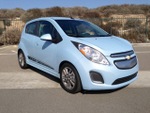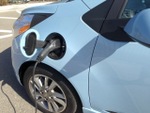
Chevrolet’s Minicar Offers More Torque Than a Ferrari 458 Italia
But don’t expect any cross-shopping between the two
General Motors’ website provides their Electric Vehicle Information under the Emerging Technology link, grouped with their progress on Autonomous Driving Vehicles and Hydrogen Fuel Cells. Since modern EV technology has been available to US consumers since 2009, with the Nissan Leaf and Chevy Volt selling more than 50,000 cars since then, it seems curious why EV would be listed as “emerging technology.” And that doesn’t even count the electric vehicles that have been rolling off production lines for more than 100 years. Maybe this is GM telling us they are not so sure about electric vehicles since they lump them with self-driving cars and hydrogen vehicles, which seem in 2013 to be still far-off concepts? This got me to thinking if it would affect the amount of attention they gave their sole pure electric vehicle, the 2014 Spark. Fortunately, it looks like my concerns are unfounded by a long shot.
The 2014 Spark EV is currently (November 2013) only available in California and Oregon and comes with a warning that there is very little dealer support outside of these states. Don’t mess with The General! The Spark, which also comes in a gasoline version, is classified as a minicar, sometimes also referenced as city, urban or sub-compact. Similar diminutive cars are the Scion iQ, Fiat 500, Toyota Yaris and Smart, to name a few.
I was driving the 2014 Spark EV 2LT powered by a plug-in, 140 hp, 105 kW AC permanent-magnet electric motor delivering 400 lb-ft of torque at from the moment you hit the accelerator (no gas pedal, remember). So what does this get you? Coming off the line it is easy to spin the tires and gets you to 60 mph in about 7.6 seconds. Top speed is rated at 90 mph and with the 21 kWh Lithium-ion (Li-ion) battery, driving range is about 82 miles. Of course using the 400 lb-ft of torque and going 90 mph will give you significantly less driving distance. In normal driving conditions, where coasting and applying the brakes regenerates electricity back into the Li-ion battery, you should be able to drive many more than 82 miles, with 100+ miles a realistic expectation.
Charging and Driving Overview

Before even considering shopping for an EV you have to evaluate your lifestyle and driving pattern. Let’s look at what GM says in the Spark EV Owner’s Manual:
“In order to maximize range, fully charge the battery at each charge event. It is not recommended to partially charge the battery.”
In simple terms, for example with a starting driving range of 90 miles on the dash gauge, a daily commute up-to 45 miles one way and the ability to plug in while at work will get you home again with ease. If at any time you are coasting or applying the brakes during this commute then you would not need to plug in for very long while at work. Then on the weekends where you would most likely drive less than your work commute distance, the end result is never having to ever buy gasoline again. If you are budgeting $250 – $400 monthly on gasoline, owning the Spark EV will bring a giant smile to your face when passing gas stations.
In addition to the regenerative braking, the primary method to recharge the batteries are these options:
120V 17 hours: discharged to a full charge
240V 7 hours: discharged to a full charge
480V 20 minutes: discharged to an 80% charge
Here then is the Must Do when driving an EV: Always know how far you are driving until you can get to a power source and always have your batteries fully charged before venturing out.
The days of pulling off the freeway and filling-up your tank with 15 gallons of 87 octane are over. You must do the math before pushing the Start button! But what if you have an emergency and the dash gauges are flashing imminent doom of zero battery charge? If you are in California and a AAA member, you can request one of their service vehicles equipped with a 480V generator to come out and give you a charge. Just like having them dump a 5 gallon can into your gas tank, this emergency charge will get you to a power source for a full charge. Please do AAA and yourself a favor, though, and don’t rely on this roadside service as part of your travel plans.
Driving Experience: Interior
Plain and simple: I like this car. The Spark EV 2LT came with a surprising list of options such as ten airbags, a seven-inch color Driver Information Center (DIC) where you will find MyLink featuring SiriusXM, Bluetooth and hands-free smartphone integration. Also on the DIC are the climate settings and multiple read-outs for the battery charge status, battery life, driving range electricity usage, plus it has a nifty graphic to show when you are using electricity or putting it back in through the regenerative braking system. The DIC will keep you informed and entertained and is located top dead center in the dash for easy viewing.

The car in 2LT trim has leatherette seats (they look and feel better than it sounds), tilt steering wheel, power windows, door locks, and mirrors and a cabin air filtration system. The audio system is GM’s 6-speaker Premium Sound unit, which sounded pretty good, and also includes a USB port. On a personal note, how about knobs for channel and volume tuning instead of the touch screen?
You also have OnStar where the push of a button connects you with a friendly GM representative to handle emergencies, directions and general assistance to make your driving experience safer and more enjoyable.
With the Spark EV designed for short city driving trips, the front bucket seats are comfortable, but could use additional leg bolstering for more support. The rear seat easily handles two full size adults, but is a tight squeeze for your feet getting in-and-out. The rear bench seat splits 60/40 and has a handy center console. And even though it’s a minicar, there is room behind the rear seat for several grocery bags.
I did find a few things curious, such as the horn honking every time the brights are flashed, a very noticeable “click” when the power door locks engage and a mechanical “clunk” when setting/releasing the Electric Parking Brake. These little things are not purchase-decision deal breakers, but seemingly could be easily remedied to raise the overall impression of the car a bit higher.
Driving Experience: On The Road
This car is quick, whether it is from a standing start or at speed when accelerating to pass, and that is in the regular drive mode. For more oomph you can press the Sport mode button that pumps out even more torque, but at the expense of battery charge and driving distance.
The Spark EV 2LT comes with a Tire Pressure Monitoring System (TPMS), remote start, ABS, 15” aluminum wheels, traction and Electronic Stability Control. So how does all this technology affect the drive? The Spark EV handles with a very tight turning radius and loves a sharp corner, all helped by the low center of gravity due to the batteries being located under the seats. But what makes for good handling comes at the expense of the ride, which can be harsh due to the stiffly sprung suspension designed to accommodate the 620 pound increase in weight from the Spark EV’s gasoline sibling.
Pricing
I was driving the 2014 Spark EV 2LT, which included all available options on this four-door, front-wheel-drive hatchback, priced at $27,820 including the $810 destination charge. The Spark EV qualifies for Federal and State tax credits that could reduce the final cost up to $10,000 in California. Clean Fleet Report recommends contacting your CPA before considering a Spark EV purchase so you are completely clear on the tax credits and how they may benefit you. Not relying on the dealer to provide this information will serve them and you best.
Spark EV base pricing before any Federal or State tax credit programs, but including the $810 Destination Charge is:
Model EV 1LT $27,495
Model EV 2LT $27,820
Also worth noting is that in California the car qualifies for the coveted car pool stickers allowing the driver, with no passenger, to use the HOV lane. This is no small thing when trying to get anywhere on a freeway in the Golden State.
The 2014 Spark EV comes with these warranties:
Basic: 3 years/36,000 miles
Battery: 8 years/100,000 miles
Drivetrain: 5 years/100,000 miles
Roadside Assistance: 5 years/100,000 miles
Bumper-To-Bumper: 3 years/36,000 miles
Scheduled Maintenance: 2 years/24,000 miles
Observations: 2014 Chevrolet Spark EV 2LT
The Clean Fleet Report staff gets asked this question frequently: “Is an electric car right for me?” The decision to purchase an EV begins with your lifestyle and driving patterns:
• Is your driving range compatible with an EV’s limitations?
• Do you have access to an electrical outlet to plug-in at your destination?
• For trips longer than 75 miles one way, do you have access to a conventionally powered vehicle, such as gasoline, diesel or hybrid?
If these three can be checked off, then the 2014 Chevrolet Spark EV could be on your shopping list. The car handles great, seats four adults comfortably, has all the creature comfort options found in more expensive cars and is attractively priced, especially considering you will never buy gasoline ever, ever again. Wow, saying that out loud leaves a nice taste in your mouth!

Enjoy your new car and as always, Happy Driving!
Other related stories you might enjoy:
Electric Car Deals May Threaten Segment’s Future
How To Find The Best Price For An Electric Car

0 thoughts on “Road Test: 2014 Chevy Spark EV”